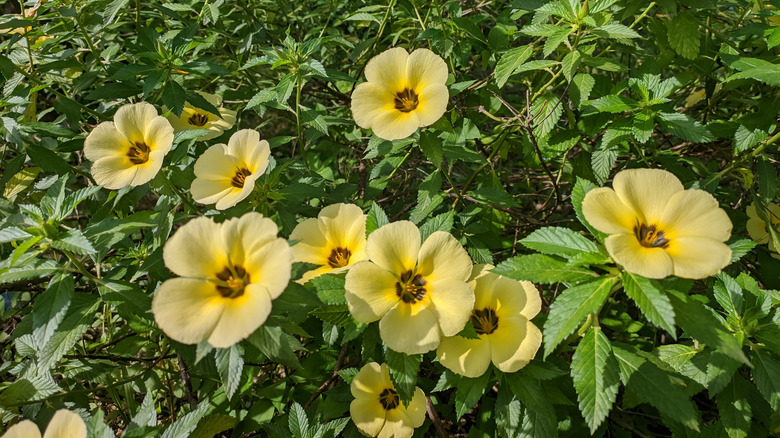A flowery garden promises floral aromas and brilliant colors. Flowers also attract important animals, especially pollinators like butterflies and bees. But some plants also repel animals you don’t want anywhere near your garden. The yellow alder (Turnera ulmifolia) belongs in this category. This beautiful shrub boasts a gorgeous flower with delicate yellow petals and evergreen leaves. The alder repels snakes, a trait which would make it a sought-after addition to the garden of anyone who can’t stand them. While this claim lies partially in anecdotal evidence, a 2024 study from Delta State University on the diversity of snake-repellent plants found it to have some scientific backing.
Snakes are not uncommon garden pests. Garter snakes can be found in many yards, and to some extent, they are beneficial when it comes to controlling other harmful pests, such as squirrels and garden mice, because they prey on them. However, being one of the most widely feared animals, snakes are not welcome in most gardens. Their fear of a flower might sound too good to be true, but indeed, some garden plants double as snake repellent. What makes the yellow alder such a threat to snakes boils down to a combination of its phytochemicals as well as its appearance. While more research needs to be done to decipher which chemicals exactly rub snakes the wrong way, the plant’s odors are what make the slithering beasts think twice before entering your yard.
The yellow alder can provide year-round snake prevention

Planting snake-repellent plants around the garden won’t just stop them from entering your yard but could also reduce the chances of having them accidentally get into your home. Snakes have keen senses, one of which is their sense of smell. They have nostrils that are used to breathe, but they don’t smell with them. Instead, they smell with their tongues. That tongue flicker that snakes are notorious for is actually how they gather scents in the air. When the tongue returns to their mouths, they smell them by bringing the scents to a special organ. This is why strong, concentrated scents irritate them, such as plants like the yellow alder.
Growing yellow alder is a rewarding experience because you’re getting a twofer — a gorgeous plant with beautiful flowers for decorating your garden, and you won’t have to worry too much about snakes. This unique plant can be grown in full sun or partial shade and slightly acidic, well-drained soil. It also flowers year-round, which is excellent news for your exterior décor. It’s a hardy plant that won’t stress you out in terms of maintenance but still needs a caring touch now and then.
Yellow alder is an invasive plant that requires pruning

The yellow alder may be a gem when it comes to keeping snakes out of your yard, but in some parts of the tropics, the plant is considered a noxious weed. It spreads by seed propagation and is a very aggressive grower. This means you will have to factor in regular pruning for the plant so it doesn’t grow out of your control. You can deadhead the flowers and cut off parts of the stem and branches to reduce the size of the thickets.
If you live in a tropical climate, you can prune your yellow alder after the flowering season in the summer without fear of damage because they thrive in hardiness zones 8 to 11. When caring for your yellow alder, you also have to beware of their common pest, the whitefly. Whiteflies are piercing and sucking insects that feed on the soft parts of the plant, such as the leaves. They can drain the life force of your yellow alder and spread to other plants. You can get rid of whiteflies by simply hosing down the plant.



